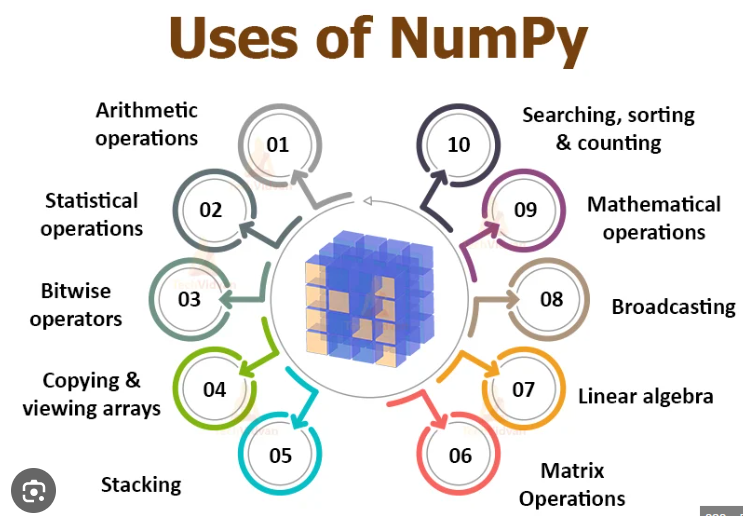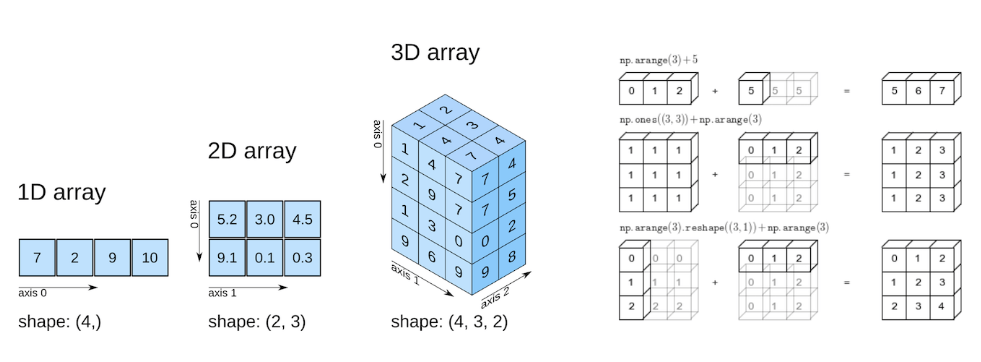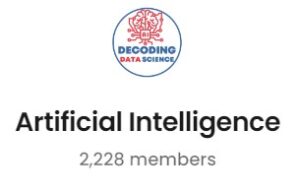Introduction
In today’s data-driven world, the ability to efficiently manipulate and analyze data is a crucial skill for data scientists and AI enthusiasts. One of the fundamental tools that enable these tasks is NumPy, short for Numerical Python. This article will delve into the world of NumPy, exploring its importance, features, and applications.
What is NumPy?
NumPy is an open-source Python library designed to handle large, multi-dimensional arrays and matrices of numerical data, as well as perform mathematical operations on these data structures. It was created by Travis Oliphant in 2005 and has since become an integral part of the Python data science ecosystem.
Why NumPy Matters
- Efficient Data Handling: NumPy provides an efficient way to store and manipulate data, making it ideal for tasks like data cleaning and preprocessing.
- Speed: NumPy is written in C, which gives it a significant speed advantage over pure Python when performing numerical computations.
- Compatibility: It seamlessly integrates with other libraries like SciPy, Pandas, and Matplotlib, forming the foundation of the Python data stack.
- Array Operations: NumPy offers a wide range of mathematical functions for performing operations on arrays, such as element-wise addition, subtraction, and multiplication.

Getting Started with NumPy
To begin using NumPy, you need to install it first. You can install NumPy using the following command:
pip install numpy
Once installed, you can import it into your Python code using:
import numpy as np
Creating NumPy Arrays
NumPy primarily deals with arrays. You can create arrays in various ways:
1. Creating an Array from a List
my_list = [1, 2, 3, 4, 5]
arr = np.array(my_list)
2. Creating an Array of Zeros
zeros = np.zeros(5)
3. Creating an Array of Ones
ones = np.ones(5)
Array Operations
NumPy allows you to perform a wide range of operations on arrays, such as:
Addition
arr1 = np.array([1, 2, 3])
arr2 = np.array([4, 5, 6])
result = arr1 + arr2
Multiplication
result = arr1 * arr2
Broadcasting
NumPy’s broadcasting is a powerful feature that allows you to perform operations on arrays of different shapes without explicitly reshaping them. It simplifies your code and makes it more concise. Here’s how broadcasting works:
Broadcasting Rules
- If two arrays have a different number of dimensions, the shape of the smaller-dimensional array is padded with ones on the left side.
- If the shape of the two arrays does not match in any dimension, the array with shape equal to 1 in that dimension is stretched to match the other array’s shape.
- If neither of these conditions is met, NumPy raises a “ValueError.”
Broadcasting Examples
Example 1: Broadcasting with a Scalar
arr = np.array([1, 2, 3])
result = arr + 5
In this example, NumPy broadcasts the scalar 5 to match the shape of the array arr, resulting in [6, 7, 8].
Example 2: Broadcasting 1D and 2D Arrays
arr1 = np.array([1, 2, 3])
arr2 = np.array([[10], [20], [30]])
result = arr1 + arr2
Here, NumPy broadcasts the 1D array arr1 to match the shape of the 2D array arr2, resulting in a 2D array [[11, 12, 13], [21, 22, 23], [31, 32, 33]].
Broadcasting simplifies many operations, eliminating the need for explicit loops or reshaping of arrays.

Advanced NumPy Techniques
NumPy offers advanced techniques for efficient data manipulation. Understanding these techniques can greatly enhance your data science and AI projects.
Slicing and Indexing
NumPy provides powerful mechanisms for slicing and indexing arrays, allowing you to access specific elements or sections of an array with ease.
Basic Slicing
arr = np.array([1, 2, 3, 4, 5])slice = arr[1:4] # Retrieves elements 2, 3, and 4
Boolean Indexing
arr = np.array([1, 2, 3, 4, 5])
mask = arr > 2
result = arr[mask] # Retrieves elements where the condition is True: [3, 4, 5]
Integer Array Indexing
arr = np.array([1, 2, 3, 4, 5])
indices = np.array([0, 2, 4])
result = arr[indices] # Retrieves elements at specified indices: [1, 3, 5]
Reshaping Arrays
You can change the shape of an array without changing its data. Reshaping is useful for preparing data for various operations or visualization.
arr = np.array([[1, 2, 3], [4, 5, 6]])
reshaped = arr.reshape(3, 2)
Concatenation and Splitting
NumPy allows you to concatenate and split arrays along specified axes.
Concatenation
arr1 = np.array([1, 2, 3])arr2 = np.array([4, 5, 6])
concatenated = np.concatenate((arr1, arr2))
Splitting
arr = np.array([1, 2, 3, 4, 5, 6])
split = np.split(arr, 3) # Splits the array into 3 equal parts
Applications of NumPy
NumPy finds applications in various domains, including:
- Data Analysis: NumPy is used extensively in data analysis to perform operations like mean, median, and standard deviation calculations.
- Machine Learning: Many machine learning libraries, like scikit-learn, utilize NumPy arrays to process and analyze data.
- Image Processing: NumPy aids in manipulating and processing images, making it valuable in computer vision tasks.
- Scientific Research: Scientists and researchers use NumPy for simulations and scientific computing.
Data Analysis with NumPy
In data analysis, NumPy is indispensable for performing essential statistical operations. Let’s look at some common data analysis tasks using NumPy.
Mean and Median Calculation
data = np.array([10, 15, 20, 25, 30])
mean = np.mean(data)
median = np.median(data)
Standard Deviation and Variance
data = np.array([12, 15, 18, 21, 24])
std_dev = np.std(data)
variance = np.var(data)
Conclusion
In conclusion, NumPy stands as the foundation of data science and AI, providing powerful tools for efficient data handling, manipulation, and analysis. Learning NumPy is essential for anyone looking to excel in these fields. Its versatility and broad applications make it a must-know library for data scientists and AI enthusiasts.
By mastering NumPy and its various techniques, you’ll be better equipped to tackle complex data-related challenges, conduct advanced analyses, and build cutting-edge machine learning models. NumPy’s impact extends across multiple domains, from scientific research to machine learning, making it a valuable asset in the toolkit of every data professional.
Frequently Asked Questions
- Is NumPy the only library for numerical computing in Python? No, there are other libraries like TensorFlow and PyTorch, but NumPy is the foundation on which many of them are built.
- Can I use NumPy for deep learning? While NumPy is not specifically designed for deep learning, it is often used for data preprocessing before feeding data into deep learning frameworks.
- What is the difference between a NumPy array and a Python list? NumPy arrays are more memory-efficient and allow for element-wise operations, making them more suitable for numerical computations.
- Is NumPy suitable for handling big data? NumPy may not be the best choice for big data due to memory limitations, but it can handle large datasets with the right optimizations.
- Where can I learn more about NumPy? You can access comprehensive learning resources on NumPy through our AI and Data Science Academy. Get Access Now.
By exploring these FAQs, you can gain a deeper understanding of NumPy and its relevance in the world of data science and AI.
If you want to learn more about statistical analysis, including central tendency measures, check out our comprehensiv PYTHON course. Our course provides a hands-on learning experience that covers all the essential statistical concepts and tools, empowering you to analyze complex data with confidence. With practical examples and interactive exercises, you’ll gain the skills you need to succeed in your statistical analysis endeavors. Enroll now and take your statistical knowledge to the next level!
If you’re looking to jumpstart your career as a data analyst, consider enrolling in our comprehensive Data Analyst Bootcamp with Internship program. Our program provides you with the skills and experience necessary to succeed in today’s data-driven world. You’ll learn the fundamentals of statistical analysis, as well as how to use tools such as SQL, Python, Excel, and PowerBI to analyze and visualize data designed by Mohammad Arshad, 18 years of Data Science & AI Experience. But that’s not all – our program also includes a 3-month internship with us where you can showcase your Capstone Project.
Are you passionate about AI and Data Science? Looking to connect with like-minded individuals, learn new concepts, and apply them in real-world situations? Join our growing AI community today! We provide a platform where you can engage in insightful discussions, share resources, collaborate on projects, and learn from experts in the field.
Don’t miss out on this opportunity to broaden your horizons and sharpen your skills. Visit https://nas.io/artificialintelligence and be part of our AI community. We can’t wait to see what you’ll bring to the table. Let’s shape the future of AI together!

